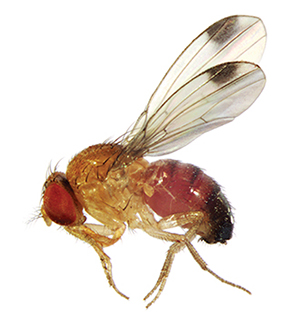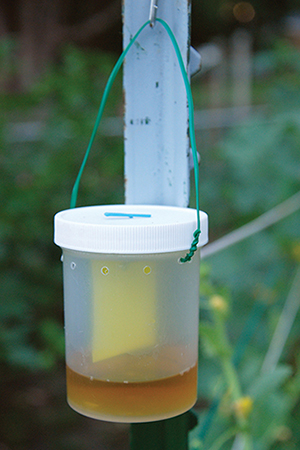G2236
The Spotted Wing Drosophila, An Invasive, Small Fruit Fly in Nebraska
The spotted wing drosophila is an invasive fruit fly species now appearing in Nebraska. Its description and methods to control it are provided in this publication.
James A. Kalisch, Extension Associate, Department of Entomology
Robert J. Wright, Extension Entomologist
- Distribution
- Identification
- Life Cycle
- Fruit Damage
- Fruits Attacked
- Monitoring
- Checking for Larvae in Fruits
- Cultural Methods of Management
- Insecticidal Control
|
The spotted wing drosophila (SWD), Drosophila suzukii, is a small fruit fly, about 3 mm in length, which closely resembles the familiar and common fruit fly, Drosophila melanogaster. It is an exotic, invasive pest from Japan and eastern Asia that actually injures ripening, sound fruit and has the potential to be an annual, devastating pest in fruit production in the United States and Nebraska.
Distribution
Since SWD was first discovered in 2008 in California on strawberries and raspberries, it has quickly spread across the continent, most recently across the Great Plains states late in 2013. It has been increasing in population locally and across the country and is generally considered to be well established as a pest requiring management annually.
Identification
SWD can be identified most easily by a conspicuous black spot near the tip of each wing of the adult male (Figure 1). Confirming the identity of a female requires magnification in order to see the ovipositor at the tip of the abdomen, which is hardened and has two rows of saw-like teeth that lacerate the skin of fruits in order to insert eggs into the flesh (Figure 2).
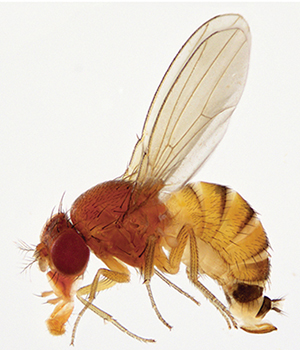 |
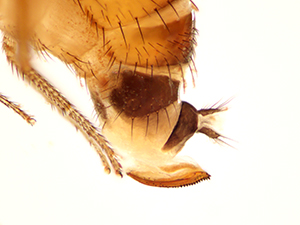 |
Figure 2. Spotted wing drosophila female |
|
Life Cycle
There are several generations of SWD per season. Adults overwinter in protective habitats and emerge in late spring. After mating, females seek out thin-skinned fruits and deposit around a dozen eggs per day, ultimately laying an estimated 300 eggs over their lifespan. Eggs take 2-3 days to hatch, and larvae (maggots) reach maturity in several days to a few weeks, depending on temperature. Pupation occurs within dried-up fruit or in soil litter, and the pupal stage may last as little as three days. At an optimal temperature of 28°C (82°F), development from egg to adult can take just over one week! Thus, under ideal summer conditions, population growth of SWD can be explosive and potentially injurious to many crops reaching maturity toward late summer.
Fruit Damage
After egg-laying, the wounds created by the females begin to sink and form depressions. Fungal rots may be introduced through wounds and induce decay. Larval feeding on fruit, yeasts and rot organisms further causes discolored regions and collapse of fruit (Figure 3). Creamy-white, mature larvae and pupae may be evident within fruit or on fruit surfaces.
Fruits Attacked
A wide variety of cultivated thin-skinned fruit crops are vulnerable to attack by SWD, including strawberry, blueberry, blackberry, raspberry (Figure 4), cherry, plum, chokecherry, black chokeberry (Aronia), peach, apricot, and grapes. Also apple, pear and tomato, especially if damaged, are attractive to infestation. Late-bearing fruit varieties are more susceptible to attack, as highest populations of SWD occur in late summer. A number of wild and ornamental berries serve as hosts as well. These include elderberry, wild plum and cherry, currants, buckthorn, serviceberry, dogwood, snowberry, mulberry, grape, pokeweed, black nightshade, groundcherry (Physalis spp.), and asparagus.
 |
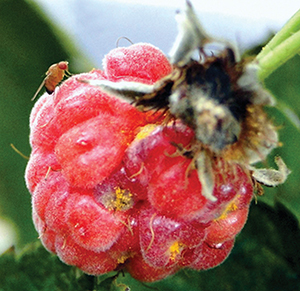 |
|
Figure 3. Sour cherry in advanced stages of decay. (Bruce Barrett, University of Missouri) |
Figure 4. SWD on raspberry. (Hanna Burrack, North Carolina State University) |
Monitoring
The utilization of traps for early detection and to monitor numbers of SWD over the season is extremely valuable as a management tool. However, trapping does not guarantee that the very first SWD flies in the area will be intercepted by the traps before they attack fruit.
|
Traps using apple cider vinegar as an attractant can easily be made and maintained. They can be built from used beverage containers or plastic jars (Figure 5). Recent research has indicated that the traps should be placed in shaded areas among host crop plants and that red-colored traps are more attractive.
Essentially a trap consists of a container with secure lid and several 1/8-inch holes drilled into it at the top. Smaller holes at opposing sides on the top are drilled to accommodate attachment of a wire or string for hanging the trap. Pour about a half-inch of apple cider vinegar into the trap. Beneath the center of the lid, attach a sticky card trap piece, obtained at a local garden center or hardware store, into the jar interior to capture adults as they fly into the jar. Replace the vinegar and sticky card as needed. Report your first capture of SWD flies to your local Extension office so that such information can be circulated to benefit other growers. Once flies are first captured and confirmed as SWD, management measures can be taken to reduce fly numbers and protect fruit crops by methods compatible with integrated pest management (IPM). Continue to check traps through the season as a monitoring tool for the benefit of other fruit crops nearing maturity.
Checking for Larvae in Fruits
Fruits suspected of being infested with larvae can be placed in the bottom of a zipper-top, heavy-duty food storage bag. Gently crush them by hand. Add a 10 percent sugar solution (1 tablespoon of sugar to 1 cup of water) to the bag. Close it and shake the bag vigorously for several seconds. Let the bag rest and wait for larvae to float to the top.
Cultural Methods of Management
Consistently irrigate crops as needed to reduce splitting of fruit skins. Ruptured skin invites fly infestation. Planting thicker-skinned varieties of fruit crops also helps minimize cracking. Since SWD flies prefer fruit that is ripe to overripe, be sure to harvest ripe fruit frequently, or slightly before fruits begin to ripen. Remove any damaged, overripe, infested or fallen fruit immediately and dispose of it so it is not accessible to flies. An effective method of disposal which kills flies and maggots in infested fruit is to seal small amounts of infested fruit in heavy-duty black trash bags, then place them out in full sunlight for at least a week. This will cause the fruit to overheat and kill all life stages of SWD. Finally, a physical method of preventive control is to cover plants or individual developing fruits with fine netting, bags, or cloth just prior to ripening to exclude flies from access to fruit. However, the key is to be absolutely sure the crop up to that point has been free of fly infestations. Covers do prevent bees from pollinating flowers, so if the crop continuously produces flowers, netting would not be appropriate.
Insecticidal Control
A number of insecticides are available for use on various fruit crops for SWD control in Nebraska. Homeowners have a much narrower choice of products than commercial growers. Many are restricted-use insecticides, largely due to toxicity to fish and aquatic organisms, and require certification to apply. It is most important to read product labels and to note the waiting period required after treatment to re-enter fields or plantings, and to harvest fruit. Examples of insecticides, each with its respective waiting period for the fruit crops, are listed in Table I.
Table I. Insecticides for spotted wing drosophila control |
||||||
Insecticide Active Ingredient (AI) (R) = Restricted Use |
Waiting Period (Pre-Harvest Interval) in Days |
|||||
Blueberry |
Cherry |
Grapes |
Plum |
Raspberry, Blackberry |
Strawberry |
|
| acetamiprid | 1 |
7 |
3 |
7 |
1 |
1 |
| azadirachtin (neem oil) | 0 |
0 |
— |
0 |
0 |
0 |
| bifenthrin (R) | 1 |
— |
30 |
— |
3 |
0 |
| carbaryl | 7 |
3 |
7 |
3 |
7 |
7 |
| fenpropathrin (R) | 3 |
3 |
21 |
3 |
3 |
2 |
| lambda-cyhalothrin (R) | — |
14 |
— |
14 |
— |
— |
| malathion | 1 |
3 |
3 |
— |
1 |
3 |
| permethrin (R) | 14 |
3 |
— |
— |
14 |
14 |
| phosmet | 3 |
7 |
7 |
14 |
— |
— |
| pyrethrins | 0 |
— |
0 |
— |
0 |
0 |
| spinetoram | 3 |
7 |
7 |
7 |
1 |
1 |
| spinosad | 3 |
7 |
7 |
7 |
1 |
1 |
| zeta-cypermethrin (R) | 1 |
14 |
1 |
14 |
1 |
— |
| NOTE: A dash (—) in a table cell means that the insecticide was not labelled for this fruit crop. In order to protect valuable pollinators such as honey bees, bumble bees and many other kinds of wild bees, look at product labels for instructions regarding safety to pollinators, if any. Also, try to apply insecticides when pollinators are least active, as in the very early morning or in the late evening. |
||||||
This publication has been peer reviewed.
Visit the University of Nebraska–Lincoln Extension Publications website for more publications.
Index: Insects & Pests
Other Pests
Issued April 2014
